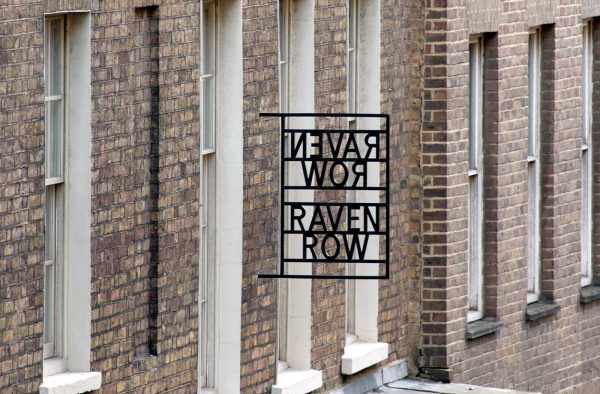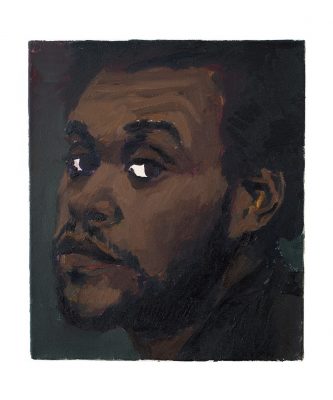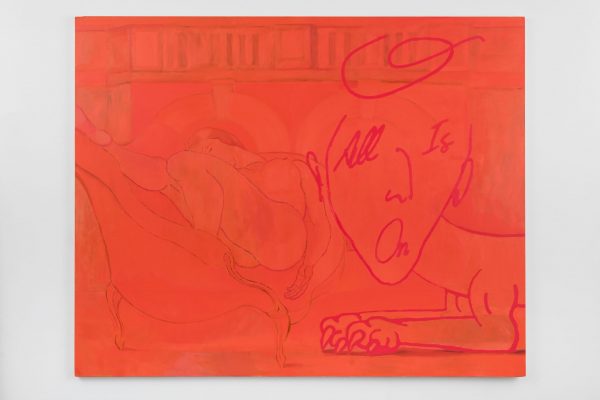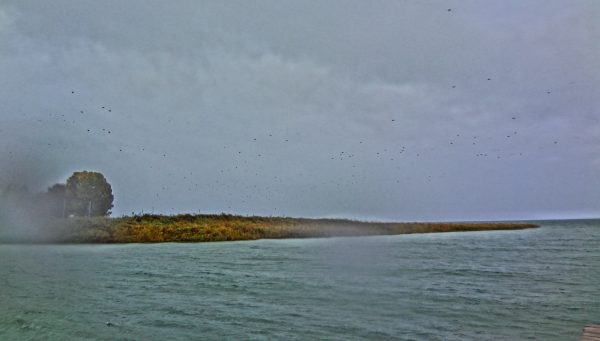Plastic Words was a six-week series of thirteen events which described itself as ‘mining the contested space between contemporary literature and art’. It did not describe itself as anything to do with ‘art writing’.
It seems, at first, a useful enough term: a kind of mise-en-abyme created by trying to write about how art uses writing, how writing uses art, and the endless permutations of each entering the other’s space. But as he introduced the second event, ‘Taking a Line for a Walk’ (16 December 2014), the critic Brian Dillon claimed the spectre of this term had almost stopped him from coming. He even called it ‘venerable’: an effective taboo in a series which was just as concerned with ideas of contemporaneity and the avant-garde. Instead, he asked his panellists – the novelist and artist Tom McCarthy, the artist Janice Kerbel, and the writer and theorist McKenzie Wark – to define their stances, by choosing an object – textual or visual – to discuss.
McCarthy greedily announced he’d chosen three, but, if we count his mention of the digressive graphic and textual lines in Sterne’s Tristram Shandy, he actually chose four. His first proper was Royal Road Test, an artist’s book in which Ed Ruscha documented the act of flinging a typewriter from a moving car’s window. Next, he showed a Google Street View image of 9 place Saint-Sulpice, Paris: in An Attempt to Exhaust a Place in Paris, Georges Perec novelises three days spent there, collecting kernels of stories which never develop. The last and most interesting of McCarthy’s choices was another artist’s book, Shadow, in which Sophie Calle got her mother to hire a private detective to follow her. Calle, the auto-/biographical subject, was actually directing the project, and the detective who wrote it up was not. It provides a handy distinction between the terms ‘author’ and ‘writer’ respectively, which McCarthy sums up with a line from Roland Barthes’s S/Z: ‘Always ask who pays’.
McCarthy explained that he’d chosen each of these examples as types of le livre avenir, ‘the book to come’, into which Mallarmé thought everything would eventually be resolved. If Barthes thought that all cultural agents of the twentieth century did was repeat Mallarmé, McCarthy thought this even truer in the digital twenty-first.
McKenzie Wark credited all of this instead to Lautréamont, the poet of the copy, for whom culture was literary communism, and illustrated his point by reading/plagiarising from his ‘object’ of choice – the comic-book account of the Situationist International in his own The Beach Beneath the Street. He argued that the technique of détournement – the opposite of quotation, in which something is taken deliberately out of its context – is now ‘unavailable for any form of revolutionary practice’, because it’s been commodified (not least by his book). Yes, we reuse material all the time on the internet, he argued, but Facebook and Google are collecting rent on it.
Janice Kerbel’s ‘object’ was the Aesop fable which ends with a dolphin welshing on his promise to help a lion fight because he can’t come onto land. The fables are a broader interest; in Hit, the piece from her song cycle Doug (2014) which she performed later in the series (28 January 2015), the baritone Luke Thomas sang the story of the eagle dropping the tortoise in a voice which descended from extremely high to extremely low.
When her talk suggested that the fables were relevant because they were strange and often brutal encounters between otherwise incompatible forms, it was difficult not to be reminded of the differences between her talk and the others’: there seemed a greater sense of space in what she said, a refusal to close everything down with rhetoric that brought it closer to an artwork than a lecture.
Though much of Kerbel’s work is constructed through writing, she responded to Dillon’s request for a ‘stance’ by shrugging off the status of writer, and ending her talk with versions of her fellow panellists’ names scrambled by Google – Thomas Dillon (an American serial killer), McKenzie McCarthy (a vet and rugby player), and Brian Wark (a wine blogger and interior designer). It seemed a neat comment on the agony of small difference involved in these sorts of self-definitions: a more playful way of making Wark’s point that where the Victorians asked, ‘Is it a good novel?’, and moderns, ‘Is it a novel?’, we now ask, ‘Who is a novelist?’
In addition to explaining the up-front anti-‘art writing’ stance, ‘Taking a Line for a Walk’ is a useful way of talking about how Plastic Words was arranged by people – John Douglas Millar, David Musgrave, Luke Skrebowski, Natasha Soobramanien and Luke Williams – who are all various admixtures of artist, writer, novelist and academic. It raised two other contests in the expanded field between art and contemporary literature: a productive uncertainty around what constitutes an ‘object’, and the issue of how the practitioners define themselves.
There are four immediate resonances around this idea of the object, each pulling in a different direction. First and most superficially there’s Objects in This Mirror, the title of Dillon’s 2014 collection of essays, with its celebration of the productive distortions of subjective perspective. Secondly, there’s the current of ‘thing theory’ in academia, most famously manifested in more popular writing by Neil MacGregor’s A History of the World in a Hundred Objects, or Edmund de Waal’s The Hare With Amber Eyes. But where this tendency is basically about finding a correlative object through which to write about lives, the contrary and more arcane philosophical phenomenon of speculative realism tries to reject what it calls ‘correlationism’ – the idea, as academic Mark Fisher explains, that ‘thought cannot have access to things-in-themselves, only to things as they appear for us’. It’s an attempt, among other things, to escape biography, and as such recalls a fourth resonance: the twentieth-century attempt the New Critics made to free ‘the text’ from historicist or biographical interpretation.
There’s something of this prejudice against life-writing as prurient and unintellectual in David Rimanelli’s famous description of Chris Kraus’s novel I Love Dick as ‘not so much written as secreted’. But if Rimanelli wanted an expression of snappy disgust for the way Kraus fictionalises a love-triangle of correspondence between her, Sylvère Lotringer, and a British theorist called Dick Hebidge, he actually ended up with an image for the production of text worthy of Barthes. The novel uses Kraus’s body, the fact of her femininity, almost as an object to spin fictions around, capitalising on the surprise of a woman doing the literary pursuing within the venerable form of the epistolary novel about love; the obsessive reconstruction which always turns out to be about the obsessed rather than their obsession. Kraus is often referred to as the ‘the art world’s favourite fiction writer’, and her work called ‘autofiction’: writing about her own life, rendered avant-garde. At its worst, the ‘auto’ denotes what a default position it’s become; at its best, it hints at new possibilities in an age of increasing automation.
Kraus proudly quoted Rimanelli at ‘The Childlike Life of the Black Tarantula: A Twentieth-Century Fable’ (14 January 2015), an event named after her favourite of the novels of Kathy Acker, whose biography she was in London to research. It’s easy to see how the commission came about: Acker’s work was attacked and defended on account of the auto-/biographical qualities which it often constructed by something like Situationist détournement; Black Tarantula starts with a list of the books Acker has borrowed from, and the explanation, ‘I become a murderess by repeating in words the lives of other murderesses’. Kraus and Acker are also connected by more than just the methodologies of biography: both have had a relationship with the philosopher and Semiotext(e) editor Sylvère Lotringer, who wrote his PhD – supervised by Roland Barthes and Lucien Goldmann – on the arch-theoretician of the art and feminism of biography, Virginia Woolf.
But where Woolf, who ran the Hogarth Press with her husband Leonard, was less concerned with the production of well-made books than with the production of well-made prose, Kraus explains at ‘Publishing Models and Technologies of Publication’ (15 January 2015) that Semiotext(e) barely do anything like traditional editing on their impressively bound publications. We could relate this to the discourses of deskilling in twentieth-century art which disavowed ‘style’ as outdated and bourgeois, but there’s a contradiction here: this same critique, applied to the Acker-Kraus vein of biography, would dismiss it as just mystified bourgeois individualism, and leave us back with Rimanelli.
McKenzie Wark – an ex-lover of Acker’s – had an interesting image of the other sort of ‘autofiction’ at the event ‘A Productivist Literature’ (17 December 2014); one that sought to escape from, rather than into, personality. It came from Andrei Platonov, a working-class Soviet writer who died in 1951, and who was often in trouble with the authorities. In ‘The Factory of Literature’, he imagines ‘a literary method that is equivalent to modernity, taking into account the experience of it’; a ‘Socialist Hollywood’. Writers would write novels, and critics develop new methods for writing that simplified and improved the writers’ work.
It seems a paradox – a product of the fact that we still think in terms of individual writers – to point out that Kenneth Goldsmith’s book Uncreative Literature makes some of the same points for the twenty-first century. For Goldsmith too, the moment of bourgeois, entrepreneurial writers finding a place in the market by creating meaning as if from nowhere passed with Romanticism. But where Platonov proposed a kind of mechanical, Fordist production in its place, Goldsmith proposes we harness the capabilities of the internet. For Wark, both visions were utopias, and both were realised, albeit by state surveillance: in Platonov’s time by the KGB, and in Goldsmith’s by the NSA.
One of the other speakers at ‘A Productivist Literature’, Nick Thurston, aligns his work with Goldsmith’s; his publishing collective, information as material (iam), describe him as a ‘regular ally’. In 2013 iam published a 144-page book which it would be remiss of me to do any work in describing:
Of the Subcontract is a collection of poems about computational capitalism, each of which was written by an underpaid worker subcontracted through Amazon.com’s Mechanical Turk service.
The collection is ordered according to cost-of-production and repurposes metadata about the efficiency of each writer to generate informatic typographic embellishments.
(…)
It reduces the poetic imagination to exploited labour and, equally, elevates artificial artificial intelligence [sic] to the status of the poetic. In doing so, it explores the all-too-real changes that are reforming every kind of work, each day more quickly, under the surface of life.
On learning that McKenzie Wark’s foreword was contracted out to a freelancer in Lahore, it is difficult to see how distinct this is from the exploitation one would assume it critiques: where Platonov’s Socialist Hollywood was defined by its collectivity of purpose, it is information as material who, as the authors, crack the whip in this instance, and return to a more nineteenth-century model.
That Barthes question – ‘Who pays?’ – leads us back to ‘Taking a Line for a Walk’, and Dillon’s ‘object’, which seems to have some special, primary status that, say, a critical commentary doesn’t. Would anyone have gotten away with citing Thurston’s densely academic lecture as an ‘object’ in this context? Perhaps instead they could have used the piece he repeatedly performed at ‘Verbalations’ (13 December 2014), leaning over a table, watching the timer on his iPhone in the top right corner, tapping at a row of old Nokias strung on cables in front of him to summon up the talking clock in different voices.
Over the three performances which punctuated the evening – starting just after six, returning at eight and finishing things off at nine – the piece grew richer and more interesting as it became clearer how formulaic it was: Thurston had a pocket-sized clip of notes with a script on. From it, perhaps we could extrapolate a point about Oulipo’s method of making artworks from arbitrary-seeming protocols: not dissimilar to the way in which most of our aesthetic experiences are now in some way mediated by coding.
‘New Contemporaneities’ (21 January 2015), a discussion between Peter Osborne, largely a philosopher of contemporary art, and David Cunningham, who focuses more upon literature, displayed a more antagonistic relationship between the academic and the artistic.
An audience member that night – fresh from Parisian exhibitions of Duchamp and the Marquis de Sade which seemed to her to frame them both as sorts of writers – asked if we might be experiencing a significant rethinking along these lines; if Plastic Words reflected something in ‘the culture’, as the Americans call it. Osborne responded by saying this was merely the becoming archival of exhibition spaces, ‘maintaining the religious, the relic status’ of the object, because these places have to show ‘stuff’. Cunningham agreed, and pointed out that visiting exhibition spaces now, with all of their reams of curatorial wall-text, had become a ‘strangely pseudo-literary activity’.
For Cunningham, these changes were down to conceptual and economic factors – ‘no one is going to make a living as an experimental poet, but they might make a living as a conceptual writer if they integrate themselves into the art world, although probably not’. There’s more on the historical backdrop to this assertion in Osborne’s Anywhere or Not At All: The Philosophy of Contemporary Art (2013). To give a brief outline of the relevant parts of his argument that evening, there was no ‘contested space’ between art and literature in their foundational moment in early German Romanticism because they shared the category of poesis. By the beginning of the nineteenth century, a hierarchy had developed in favour of literature – which was now considered art in the singular – while painting, sculpture and architecture were considered arts.
In the post-war Western capitalist world, a ‘post-medium’ movement developed, and literature, which was Art, now became merely an art; the miscellaneous ‘arts’ were now the Art at the top of the hierarchy. Hence ‘conceptual writing’, which comes – in analogy, one supposes, to conceptual art – into the space of Art in a bid to reclaim the prestige it once had, gaining its cultural meaning from the art institution.
Conceptual art chose its name as a comment on the perceived dearth of concepts in the art of the time: Osborne says we thus now have to use the term postconceptual, and as for the idea of conceptual writing: surely, ‘one might have expected writing to be always already conceptual’.
This all brings us to a present in which, in Osborne’s words, ‘Self-consciously literary writing has already auto-destructed outside the art world and the literary world. So it looks like turning into a kind of care home for the literary.’
It’s a useful narrative, but it misses out how this kind of academic discourse also has its origins in post-Enlightenment Germany; as a writerly genre, the PhD thesis is essentially an autofictional Bildungsroman, performatively carving out a space in the market for an individual academic by creating meaning as if from nowhere. The same is certainly true of grant applications and position papers. While Cunningham was speculating about the economic motives of experimental poets to work their way into the art world, he was in fact sitting opposite Luke Skrebowski, who performed wryly technological experimental poetry at ‘Verbalations’, but makes his living as a lecturer at Cambridge.
I’m under no illusions that this essay is nearer the novel than it is the thesis, and there is, as we’ve seen, something profoundly depressing about summing up the contested space between art and contemporary literature in terms that seem to suggest academia is now the master discourse.
So let’s turn to a different ‘object’: David Musgrave’s short story ‘Skeleton + Flesh’. Performed on 28 January 2015, it featured a protagonist made from mushroom protein grown on a human skeleton, who had worked on a tuna fishing boat, rapidly completed a PhD, and got a job as an art history lecturer. The slides that accompanied it were stylised monochrome pastiches of academic presentations, making subtle comparisons between the industrial manner in which tuna boat and university handled their live charges. Later, Musgrave made a visual comparison between a large, looping, paralysing, parasitic worm with which our artificial lecturer had become infected on the tuna boat, and the snake with which Laocoön wrestles in the famous sculpture: a sculpture which forms the centrepiece of one of the most famous discussions of the boundaries of art and literature in German Romanticism, Lessing’s ‘Laocoön’.
Musgrave’s use of Lessing is a détournement of an argument at least as old as Horace, ‘ut pictura poesis’, or ‘as in painting so is poetry’. This made renewed sense in the twentieth century, when semiotics and structuralism looked to read both modes of expression as merely arrangements of signs. Lessing also popularised the argument that poetry is an art of time, whereas the ‘plastic arts’ – by which he means sculpture and 2D graphic work – is an art of space. Musgrave’s story covered much of the same territory as ‘New Contemporaneities’ with a sort of sparse comic eloquence reminiscent of Janice Kerbel’s fables: maybe one of the objects could have been Velazquez’s venerable ‘Las Meninas’, an endlessly productive process of mirroring, by a man who once painted himself as Aesop.
***
But who paid? Raven Row’s backing by the grocery dynasty heir Alex Sainsbury means it had the unique combination of resources and inclination to physically bring together a line-up of the most prominent thinkers to talk out these contestations, and add some newer ones, including the organisers. One of its failings, perhaps, was that it was almost exclusively conducted in English, with the exception of a couple of moments of UN-style translation by Raven Row’s curator Anthony Hudek. (Hudek also curated Marginalia, an exhibition in the space around the events, which would require its own review.)
This must have been a disappointment to Helen DeWitt, if not a surprise. In her debut novel The Last Samurai, the narrator picks up a copy of Schoenberg’s Harmonienlehre on her way to buy a dress:
This was all commonplace and banal to a painter or musician, and yet the languages of the world seemed like little heaps of blue and red and yellow powder which had never been used – but if a book just used them so that the English spoke English & the Italians Italian that would be stupid as saying use yellow for the sun because the sun is yellow. It seemed to me reading Schoenberg that what the writers of the future would do was not necessarily say: I am writing about an Armenian grandfather Czech grandmother a young biker from Kansas (of Czech & Armenian descent), Armenian Czech English OK. Gradually they would approach the level of the other branches of the arts which are so much further developed. Perhaps a writer would think of the monosyllables and lack of grammatical inflection in Chinese, and of how this would sound next to lovely long Finnish words all double letters & long vowels in 14 cases or lovely Hungarian all prefixes suffixes, & having first thought of that would then think of some story about Hungarians or Finns with Chinese.
An idea has only to be something you have not thought of before to take over the mind, and all afternoon I kept hearing in my mind snatches of books which might exist in three or four hundred years.
At ‘From Situationism to Sabermetrics: Experiments for the Novel in the Age of Big Data’ (8 January 2015), she explained that she gets depressed if she reads too much English; that’s not the world we live in, in all its rich linguistic polyphony. She has no time for the ‘learned helplessness’ of English speakers in the face of the multiplicity of the world’s languages; at one point she reflected that such people may be victims of extremely poor design. (I imagine I wasn’t the only such victim in her audience.)
She illustrated her point through slides of instructional guides, translations, and an image of the Rosetta Stone; she’s a disciple of a man the New York Times described as ‘the Leonardo da Vinci of data’, the theorist and sculptor Edward Tufte. Indeed despite all this discussion of language, the most abiding image of her talk was actually sculptural: the casts of air behind library shelves in Rachel Whiteread’s ‘Untitled’, often with the ink and finger-grease clinging to the plaster; images of ‘the sullen obstinacy of empty space’, as she put it. DeWitt actually brought her own travelling library, as well as handouts with a reading list.
But the comparison she brought on herself was with Michael Lewis, the sabremetricist – or scientist of baseball – of the title of her talk: she shares his capacity for ‘infinite outrage at stupidity’. Though DeWitt has no interest in the game per se, she’s fascinated by Lewis’s scientific approach to improving the way in which it is played. There are, she says, ‘obsessive analytical qualities of sports writing which tend to be sidelined in fiction’. ‘Sidelined’, with its suggestion of ineptly managed potential, is particularly apt.
All of this – the languages, the history, the expressive disciplines, the uncompromising intellectualism – Luke Williams called it ‘the relocation of pleasure in difficulty’ in his introduction – seems very modernist, very Ezra Pound. But as with most of the events I’ve discussed, the stated legacy was of the Situationist International.
It makes sense: in Wark’s words, Situationism was ‘not a collaboration between specialists, but the overcoming of specialisation in the name of a new kind of collective activity’; in those of the Situationist Constant Nieuwenhuys, it ‘did not constitute a real movement. The adherents came and went and the only view they shared was their contempt for the current art practice.’
Plastic Words historicised this sense of a legacy at the afternoon (30 January 2015) on Isidore Isou, founder of Lettrism, the movement which preceded Situationism, and gave it many of its key techniques. The art historian T. J. Clark’s contributions from the audience gave proceedings an interesting depth; not just because he was a Situationist himself, but because he’d just published an essay in the London Review of Books on the problems of properly fitting William Blake’s political radicalism into either respective art-historical or literary canons. This issue of institutionalisation is a reminder of the unlikeliness that this series was able to unfold in the way it did: it’s tempting to think that bigger galleries would have been unlikely to give over so much space and time to something so frequently weird; smaller ones would possibly have been less white-cubeish and polite, but they wouldn’t have been able to fly everyone over. The organisers are talking about arranging more events in the future; we’ll find out then. But for now, if ‘art writing’ won’t do, perhaps ‘plastic words’ – with all its senses of malleable, provisional shape – will.




